For five days in early January, George Morris arrived at the ring at about 7:30 each morning, meticulously dressed in polished boots, shined spurs, breeches, a solid-colored belt and a polo shirt when the Florida weather was balmy or a plaid flannel shirt on nippier days.
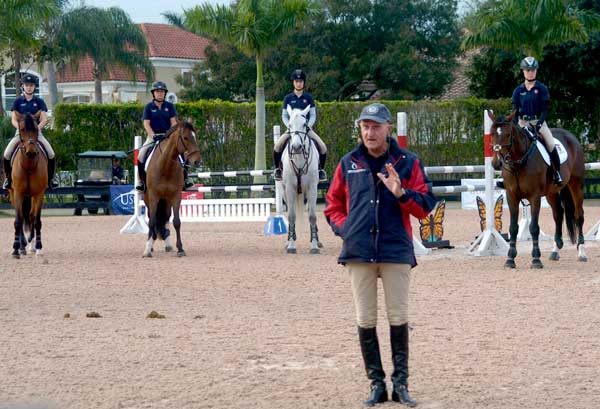
The Olympic silver medalist and former U.S. show-jumping coach started some days quizzing the young riders gathered around him on topics such as the German Training Scale—rhythm, looseness, contact, impulsion, straightness and collection—or the tempo of the walk (four beats), the trot (two beats) and the canter (three beats). Another day, he discussed riding without stirrups to improve rider tightness and balance.
His mission was to share some of the classically correct riding principles he has learned over the past 65 years with the riders participating in the eighth annual George H. Morris Horsemastership Training Session at the Palm Beach International Equestrian Center in Wellington. The riders, ages 15 to 21, had been selected to participate because of their success in equitation, jumper and hunter competitions in 2013.
“What’s important is you develop a system based on correct classics,” he told them and the 100–150 auditors who attended daily. Audience members included luminaries of the sport such as Olympian Anne Kursinski, who also gave a riding demonstration early in the week, and Olympic dressage rider Michael Barisone, who said he was there so George’s “attitude and mentality of self-discipline and excellence” could rub off on him.
Designed to develop a pipeline of young horsemasters for future U.S. Equestrian Teams, the comprehensive program encompassed stable management and veterinary and farrier care in addition to the daily lessons in the saddle from George. This article shares 15 of his training insights, important for horsemen of all levels and ages.
1. Create Impulsion
George started each riding session by having riders walk and use their legs to ask the horses to move forward and create impulsion. “The hind leg is where it starts,” he said. A rider breaks up resistance in the horse by encouraging his hind legs to come forward and under his body. When that happens, the horse’s croup starts to drop. Then the base of the neck, where it attaches to the shoulder, comes up. As a consequence, the horse’s head drops and he starts to round.
As riders urged their horses forward with their legs in one session, George told them to keep their hands up over the withers in a straight line with the bit. “You use your leg until the horse stretches to the bit,” he said to one rider as he walked beside her and lifted her hands. “This is contact.”
The next day, he further explained: “You want to feel as if you’re pushing the horse’s head down. Don’t pull the horse’s head down.” It’s important to take and give, he added. “When I feel the outside rein and the horse comes back, I instantly give.”
He reiterated these points several times throughout the week while riders worked at the walk, trot and canter.
2. Keep Him Straight
Throughout the week, George reminded riders to use inside legs at the girth to press the horses into the outside reins to develop and maintain straightness, which is necessary for back-to-front collection.
There are two types of straightness, he explained. The first is the bottom line of the horse. Does his left hind hoof fall into the print of his left fore and his right hind into the print of his right fore? Most horses naturally go in a little haunches-in. The second type of straightness is the horse’s topline, from the dock of the tail to his poll.
On a straight line, the horse needs to be tracking straight, and on a circle, he must be bent in accordance with the curved line. Many riders overbend their horses, making them crooked, he said. He also reminded riders that to be straight, they first must feel a forward quality in their horses’ gaits.
In the canter, George said he wanted the riders to use their inside legs to outside reins with a slight inside flexion just so they could see the back corner of the horse’s inside eye. But, he warned, “That’s ALL,” the flexion he wanted.
3. Carry the Hand
On the fourth day of the training session, reserved for working without stirrups, George rode a horse whose conformation made it easy for him to resist contact and go with a high head carriage. To ask a horse to round, George said he uses an “old-fashioned French system with my hands. I show [the horse] an early lesson that he can’t get his head higher than my hand. … I’m keeping my hand up and driving him forward with my inside leg, very much on the outside rein. When he’s in a beautiful place with his neck arched and round, I soften and lower my hand.” He said that he doesn’t use gadgets like draw reins or tougher bits. “You won’t see me sawing on the horse’s mouth,” he added.
George taught this method to the riders throughout the week. For example, when one rider’s horse resisted, he told her to raise her hands, close her fingers and push with her leg. “You have to resist the horse’s resistance so the horse starts to accept contact.” When the horse softened in the mouth, George told the rider to be sure to give with her hands as a reward. He explained that many riders are taught to lower their hands if they feel resistance, “but that is rewarding the horse for disobedience.”
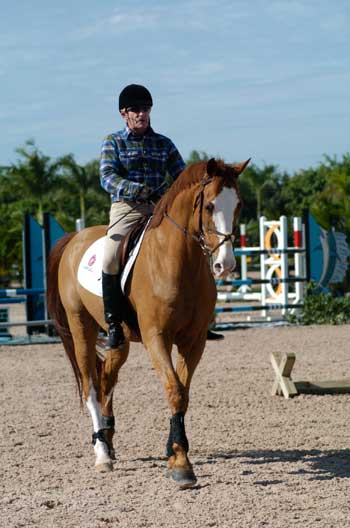
4. Make Every Transition Count
Throughout the session, George told riders to work on transitions between gaits, reminding them to “make every transition count.” He wanted the horses uphill in the transition and in front of the leg. During walk–halt transitions, he instructed riders to use four parts of their bodies to ask for the halt: back, seat, legs and hands. He told them to stretch in their spines which gives them power, keep their legs on and close their hands. When the horses responded, he said the riders should give a little with their aids.
He also had the riders work on transitions within the gaits. At the canter, he instructed them to lengthen for 10 strides and shorten for 10. To lengthen, they just needed to relax the hands because the horses were already traveling with impulsion. In the collection, “I want to see how slow they’ll go,” he said. If the horse fights the bit, “we close our fingers. We don’t surrender and drop our hands.”
5. Establish Rhythm With Cavalletti
During the flatwork, George had the riders trot over cavalletti to help create a regular rhythm. In one variation, riders trotted over two cavalletti set on a short bending line. They approached on the right rein, trotted over the first cavalletti, rode the bending line to the left, trotted over the second cavalletti and turned to the right. The alternating bending helped to supple the horses.
In another variation, riders trotted over a serpentine pattern of three cavalletti set across the wide arena. Again, the focus was on maintaining a steady rhythm. The work also helped the horses become more comfortable stepping over small obstacles, George said.
6. Supple with Lateral Work
In each of the flatwork sessions, George instructed the riders to do a variety of basic lateral work—leg-yield and shoulder-fore—and then more complex movements—shoulder-in, shoulder-out, haunches-in and the even more-advanced half-pass. The work encourages a horse to be submissive to the rider’s legs and breaks up his resistance behind so he becomes more supple, he explained. It also quickly collects the horse from back to front, which “is called engagement. It gets the horse accepting the leg,” he said.
One day, the riders worked on shoulder-fore, in which the horse’s inside hind leg tracks between the two front legs and the angle of his front end is less than 15 degrees. Going to the left, George told them to move both hands to the inside a few inches and use the inside left leg to bend and push the horses to the right rein. If a horse started to stiffen on the inside rein, he said to very delicately play with it.
After a few steps at shoulder-fore, riders went straight and forward. Then they rode haunches-in and alternated between the two movements every few strides. “Get that horse dancing behind,” George said. Then they rode a working trot to re-establish impulsion, changed direction and repeated the lateral work.
George also pointed out that all horses have a stiff side and that “our goal is to make both sides the same as possible. Crooked horses can’t be collected.” You do this by working on circular tracks and figure eights, especially in lateral work.
7. Spiral In and Out
To continue to supple the horses throughout their bodies, George had the riders spiral in on three circles at the canter. They used their outside legs to displace the horses’ haunches in while bending them around the inside legs. If a horse resisted, the rider could use a leading inside rein and an outside neck rein. When the horses relaxed a little, George said the riders could give slightly with their inside reins while the outside reins remained more solid. Then they spiraled back out. After the three circles, the riders went straight. They repeated the exercise a few times in one direction, and then they changed direction and repeated it.
8. Counter-Canter to Collect and Balance
Throughout the week, George had the riders do one of his favorite exercises in the canter: Ride a half-turn and maintain the counter-canter in the opposite direction. He likes it because it collects and balances the canter. So riders on the right lead rode a half-circle back to the rail so they were traveling to the left still on the right lead. The outside left leg (now to the inside of the circle) was behind the girth regulating pace, the critical inside leg was at the girth and the inside right rein played, giving and taking, relaxing when the horse softened in the jaw. “That inside rein is desperate to give,” George said. Riders made a few of these half-turns to change direction, maintaining the counter-canter. The work also helped the horses start to be in self-carriage. “Self-carriage is where a horse holds himself, maintaining his own balance and impulsion,” George explained.
9. Stay Straight in Flying Changes
George said that many horses today do not sit down during flying changes but are high in their croups and sulky. To fix that, he had the riders make big half-turns, sitting down in the turn so the horses would learn to accept the seat and not pull the riders out of the saddle. Then he wanted the riders to keep the horses absolutely straight using the inside leg at the girth to outside rein. When the riders asked for the change, he told them to change just their aids, moving their new inside leg to the girth and pushing with it, especially if the horse kicks out or is high in the croup, and taking a feel of the new outside rein. The outside leg is back and passive. He said too many people just grab the new inside rein to ask for the change, making the horse crooked and often late with the change behind. He wanted the horse to make the changes exclusively from the riders’ leg aids. “It’s cheating if you use your hands,” he said.
10. Lighten Up
Any time the riders asked for pace, such as when they were galloping or jumping, George encouraged them to be light on their horses’ backs with their hip angles closed and their upper bodies forward about 30 degrees. This allowed for a smoother and softer ride and kept them from disturbing their horses’ self-carriage. “Watch [Olympian] Nick Skelton,” George said. “He is a master because so much of the time, he’s over his horse letting his horse do his job.”
At the start of the final day’s training session, George explained to riders and auditors that Italy’s Federico Caprilli revolutionized fast riding (galloping and jumping) in the early 1900s. Prior to that, people rode with long stirrups and sat back when jumping and racing, which hindered the horse’s hind end. Caprilli advocated shortening the stirrups to get the rider off the horse’s back to make it easier for the horse to do his job.
There are times when a rider needs to sit more defensively, such as over a spooky fence. But as the riders trusted that their horses would jump such fences, George said they could return to the lighter position.
11. Ride with Pace To the Base
On the third day, George had the riders warm up over a small triple-bar jump set on the short side of the arena. He wanted them to get sufficient pace to the jump, cut the corner a little and let the horses go forward to it. That work helped produce impulsion and looseness. “As I let the horse go forward, I measure the fence,” he said. When the riders saw a distance, he told them to ride forward past it just a bit so the horse jumped up from the base of the fence. “Pace to the base,” he explained.
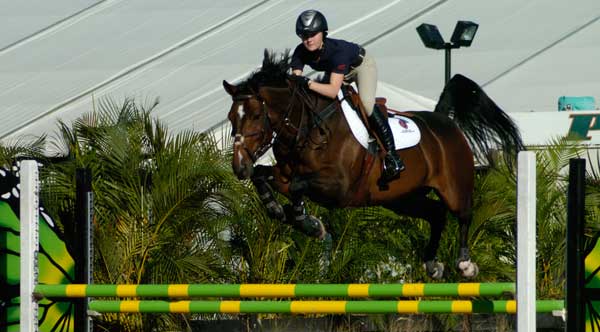
The final day, George had them gallop a long approach to a vertical, get to the base of the jump and then relax the reins. This work would teach the horse to leave from the deeper distance by rocking back onto his haunches and jumping up. He then learns to jump round and careful, which helps his bascule—the “holy grail of jumping,” George said.
12. Practice What is Difficult
After getting the horses forward over the triple bar, George had the riders work over a liverpool to a vertical jump that was set on a bending line to the right, 52 feet from outside corner to outside corner. Riders first rode the outside part of the line in four quiet strides, teaching the horse to collect. Next the riders opened up their horses and jumped the line in three strides. Riders then halted and rode the line in four strides again.
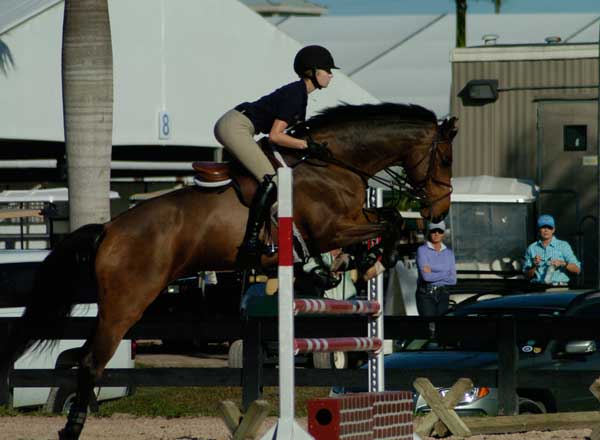
If a horse raised his head or twisted when fitting in the four strides, George told the rider not to “freak out” and lose her position and give up. Instead he wanted the riders to stick to their guns and keep asking the horses to fit in the strides. He said riders too often try to protect their horses and “keep them in cocoons” rather than do the work that is hard.
13. Let Go Out of the Turn
On the final day’s jumping course, George explained the nuances of riding a turn. At the apex of a big rollback turn from one large oxer to another, the rider should be relaxing and letting go of the horse and focusing on the line and distance to the next fence. If you do this, he said, you’ll “measure the fence infinitely better.” If the horse is not listening to the half-halt or is cross-cantering by the time he reaches the turn’s apex, a rider needs to return home and practice—“that’s homework,” George said. Problems like this can’t be fixed on course in the show ring.
14. Keep Riding to a Difficult Distance
George ended one day’s jumping session by having the riders tackle a big crossrail that was “ugly” but simple and invited straightness. When one of the riders missed her distance to the jump, George said, “If the distance is difficult people, work it out. Don’t quit.” He told her to hold the horse a little and use leg to help him. A rider can’t get to the off-stride and be soft with her leg and hand, he said.
15. Stay Positive
When some horses had trouble and refused on the final day’s jumping course, George reminded the riders not to be tentative because a horse will sense that and question whether or not he should jump. “The relationship between horse and rider is closer than any two beings, even if you’re married,” he said, adding, “When a horse gets tentative, you don’t get tentative. That’s the kiss of death. … You get positive.”
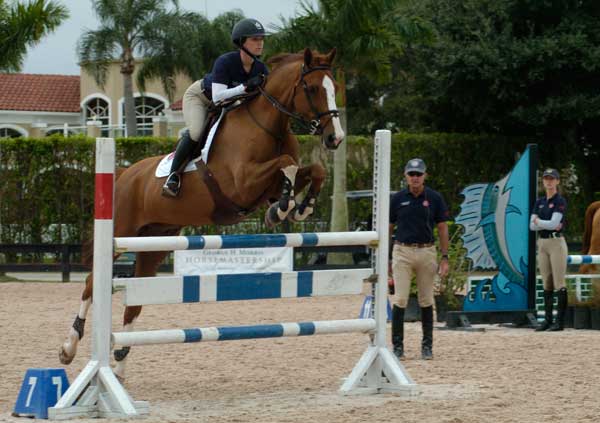
George concluded the week’s training session by explaining that its goal is to encourage a professional rider’s mentality through the whole spectrum of horse care. “Each person will have his own riding system and way of working a horse,” he said. “The basis of this clinic was classically correct riding.”
The 2014 George H. Morris Horsemastership Training Session was presented by the United States Hunter Jumper Association and supported by the U.S. Equestrian Federation, the U.S. Equestrian Team Foundation, Practical Horseman and the Winter Equestrian Festival.
This article originally appeared in the April 2014 issue of Practical Horseman.
Save










